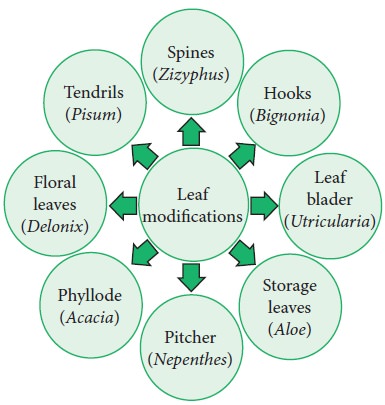Chapter: 11th Botany : Chapter 3 : Vegetative Morphology of Angiosperm
Modification of Leaf
Modification of Leaf
The main function of the leaf is food preparation by photosynthesis. Leaves also modified to perform some specialized functions. They are described below.
I. Leaf tendrils
In some plants Stem is very weak and hence they have some special organs for attachment to the support. So some leaves are partially or wholly modified into tendril. Tendril is a slender wiry coiled structure which helps in climbing the support. Some of the modification of leaf tendrils are given below:
Entire leaf—Lathyrus, stipules—Smilax, terminal leaflet—Naravelia, Leaf tip— Gloriosa, Apical leaflet—Pisum, petiole—Clematis.

II. Leaf hooks
In some plants, leaves are modified into hook-like structures and help the plant to climb. In cat,s nail (Bignonia unguis-cati) an elegant climber, the terminal leaflets become modified into three, very sharp, stiff and curved hooks, very much like the nails of a cat. These hooks cling to the bark of a tree and act as organs of support for climbing. The leaf spines of Asparagus also act as hooks.

III. Leaf Spines and Prickles
Leaves of certain plants develop spinesent structures. Either on the surface or on the margins as an adaptation to herbivory and xeric conditions. Example: Argemone mexicana (Prickly poppy), Solanum trilobatum, Solanum virginianum. In xerophytes such asOpuntia (Prickly pear) and Euphorbia leaves and stipules are modified into spines.
Prickles are small, sharp structure which are the outgrowths from epidermal cells of stem or leaf. It helps the plant in scrambling over other plants. It is also protective against herbivory. Example: Rosa spp, Rubus spp.
IV. Storage Leaves
Some plants of saline and xerophytic habitats and members of the family Crassulaceae commonly have fleshy or swollen leaves. These succulent leaves store water, mucilage or food material. Such storage leaves resist desiccation. Example: Aloe, Agave,Bryophyllum, Kalanchoe, Sedum, Sueada, Brassica oleracea (cabbage-variety capitata).
V. Phyllode
Phyllodes are flat, green-coloured leaf-like modifications of petioles or rachis. The leaflets or lamina of the leaf are highly reduced or caducous. The phyllodes perform photosynthesis and other functions of leaf. Example: Acacia auriculiformis (Australian Acacia),Parkinsonia.
VI. Pitcher
The leaf becomes modified into a pitcher in Nepenthes and Sarracenia. In Nepenthes the basal part of the leaf is laminar and the midrib continues as a coiled tendrillar structure. The apical part of the leaf as modified into a pitcher the mouth of the pitcher is closed by a lid which is the modification of leaf apex.
![]()
![]()
![]()
VII. Bladder
In bladderwort ( Utricularia), a rootless free-floating or slightly submerged plant common in many water bodies, the leaf is very much segmented. Some of these segments are modified to form bladder-like structures, with a trap-door entrance that traps aquatic animalcules.
VIII Floral leaves
Floral parts such as sepals, petals, stamens and carpels are modified leaves. Sepals and petals are leafy. They are protective in function and considered non-essential reproductive parts. Petals are usually coloured which attract the insects for pollination. Stamens are considered pollen bearing microsporophylls and carpels are ovule bearing megasporophylls.
Related Topics